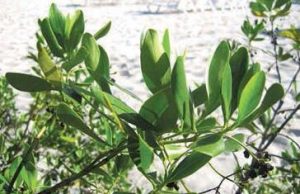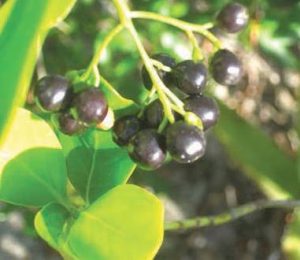Black torch shrub (Erithalis fruticosa) is threatened in Florida because the coastal hammocks in which it grows have turned into condominiums. The loss of habitat has significantly reduced the number of 6-foot shrubs. It is a buffer plant on the coastline with a high tolerance for winds. It can hold its own on the beach, surviving a short inundation of seawater or drought.

Dark-green leaves love the full sun on the edge of a beach. They are evergreen, lightly veined and simple. Leaves emerge opposite with stipules at the petiole base. The smooth ovate leaves grow on the end of branch tips. The word “erithalis,” as defined by Plinius, means “luxuriantly flourishing.” Linniaus actually classified and named the plant in 1759. Black torch shrubs are found in the Lower Keys and throughout the Caribbean along the edges of hammocks and pine rocklands. Flowers bloom profusely off and on, all year. They glow against the dark green like a sky full of stars. Five is the key number: five showy white petals, five sepals and five stamens. In the evening, small blooms smell like fragrant jasmine.

The fruit starts green, turns red and dark purple, then a dried black. Wildlife enjoys them and they are sweet for humans, too. But don’t eat the seeds. To propagate the seeds, de-pulp them and plant. Black torch shrubs also may be propagated with woody stem cuttings dipped in root toner and planted. Birds are fond of the fruit, butterflies like the nectar of the flowers, and the foliage hides rabbits and other wildlife. The many folk uses for this plant include the brewing of teas to treat hemorrhoids, measles and skin sores, or for use as a diuretic.
Bertram Forbes has a YouTube video of how the Bahamas’ bush medicine men prepare a burning branch of black torch in order to hunt for land crabs. Directions 1) Cut a branch off the bush with a machete. Look for a straight branch, 3 feet long. Cut off the leaves. 2) It is about one-inch in diameter. Cut it lengthwise into four sections of the diameter going down 6 inches from the top. 3) Separate the four sections with two small sticks jammed in the bottom between the cut sections. 4) Light the green wood with a lighter. (The wood burns better if it is dried, so planning ahead is good.) 5) Catch the crab with the stick and put it in a basket. 6) When hunting, use two torches to make sure one is ready at any moment. This practice is prehistoric. Now, hunts are often on the full moon eve.
Land crabs are a primary source of protein in Southeast Asia. Recipe: Remove the shell. Discard the gills, bile and intestine. Twist off claws and scrape out meat from shell. Combine chopped onions, hot chili peppers, pumpkin seeds and grated coconut meat. Add crabmeat. Stuff shell, replace front plate and tie with string. Boil stuffed shell and claws in watered coconut milk. The dish is done when the crab shell is red.
Key West Master Gardener Robin Robinson was a columnist for the Chicago Daily News and syndicated with Princeton Features. Her books are “Plants of Paradise” and “Roots, Rocks and Rain: Native Trees of the Florida Keys.”
